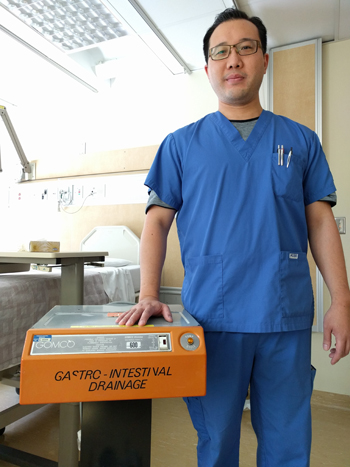
This old Gomco machine can thank Toronto General Hospital nurse Kelvin Mak for finally getting to retire. (Photo: UHN)
Kelvin Mak was almost out the door to start a paternity leave when he paused to record a safety concern on his unit's huddle board, setting off a chain of events that led to a major equipment upgrade at Toronto General Hospital (TGH).
One of Kelvin's patients that weekend needed a gastric suction machine called a Gomco, so named for the original manufacturer, to prevent a painful bile accumulation in the stomach. If a blockage prevents bile from draining out of the stomach, the Gomco sucks it out through a tube in the patient's throat.

When a Gomco isn't working, staff send the unit back to the Central Processing Department for cleaning and repair by biomedical engineering, then request another one, wasting time replacing units until they find one that works.
That was the status quo until Kelvin, nurse, 6A, TGH, spoke up.
"We had to order a replacement machine and it took about 12 hours to arrive because all the other machines were in use, delaying the patient's care," says Kelvin. "This happened over the weekend, so I noted it as a safety concern on the huddle board, and then I went on paternity leave."
New machines soon began arriving
Upon his return to work a couple of weeks later, Kelvin says: "I saw a poster about the new machines."
Not long after that, they started rolling them out on the floors.
Here's what happened after Kelvin noted his safety concern that weekend.
On Monday morning, his manager, Marleine Elkhouri, raised the issue to the hospital leadership team at the site safety huddle. Linda Flockhart, Clinical Director, Peter Munk Cardiac Centre (PMCC), volunteered to take it on.
"Recognizing the importance of this equipment, we secured emergency funding to purchase new machines," says Linda. "The biomedical engineering team has done a fabulous job keeping the Gomcos functioning but they needed to be retired."
Linda, Clare Fielding, Clinical Nurse Specialist for Critical Care at PMCC, Aileen Gunda, TGH Central Processing Department Manager, and biomedical engineer Matt Kitt, worked together with Ryan Saunders, Plexxus buyer, to find the best product and prepare the new equipment for circulation.
Replacing equipment in more timely way
After reviewing several other options, they decided to replace the current system to avoid delays because of the urgent need for the new machines.
"Patient safety was being compromised and staff were struggling to provide the right level of care," says Linda. "As an organization we must have a plan to replace equipment before it reaches the end of its life.
"Staff need to raise all issues, new or long-standing, at safety huddles so the leadership team can take action. We all need to work together to ensure we have the tools we need to provide safe care for our patients."
Currently, the new machines are moving into circulation as the old ones are removed.
Like the Gomcos, standards at UHN are changing. Staff have always been expected to speak up about broken equipment, or any other safety concern, but the new safety huddles are an action-oriented process for ensuring changes are made and the loop is closed.
Out with the old, in with the new.
